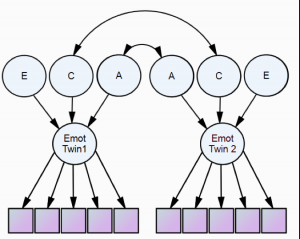This blog explains our latest publication in which we analysed Twins Early Development Study data on emotional problems across childhood and adolescence. Accurate assessment is difficult but essential if we are to understand the influences on emotional problems. We took advantage of longitudinal data (i.e. taken across time) to define a core trait: stable emotional problems. This trait is highly heritable and significantly increases power for research.
Background
There is a pressing need to understand the childhood origins of emotional problems, to identify risk factors, and to develop preventative methods and treatments. Emotional problems such as anxiety and depression are extremely common and disabling. They have a strikingly early age of onset (11 for anxiety), but are only moderately stable, meaning that symptoms tend to fluctuate across childhood and adolescence. Importantly, longitudinal twin research has shown that stability in emotional problems is predominantly driven by stable genetic factors. The research so far suggests that understanding the genetics of stability will help us to understand the genetics of the phenomena.
The first step in understanding the genetics of emotional problems is to estimate heritability. There are two key heritability methods: twin and SNP heritability. Since SNP heritability only captures the additive effects of common variants that we measure, SNP-based estimates only pick up around half of the effect size of twin estimates. Even so, we were surprised (in our previous article) to find negligible SNP heritability across many measures of behavioural and emotional problems, and across multiple ages. Luckily, evidence from longitudinal twin studies hinted that measuring stability in emotional problems could help tap into underlying genetic vulnerability.
Hypothesis & Methods
Is SNP heritability increased by capturing common variance in measures of emotional problems across time?
To test this hypothesis, we ran a single-factor latent trait twin model to extract commonalities between measures across time and captured a core emotional problems trait.
The purple squares in the figure represent the observed measures, which are indicators of the single common factor of stable emotional problems (‘Emot’). The common factor is decomposed into genetic, shared, and non-shared environmental influences (ACE respectively). We aggregated data from a diverse emotional problems measures: 4 types of questionnaires (e.g. Moods and Feelings Questionnaire, Anxiety Sensitivity Index), 3 different ages (7, 12 and 16), and 3 reporters (parent-, self- and teacher-report). Our sample consisted of 6110 twin pairs with genotype and emotional problems data.
We extracted stable emotional problems factor scores from this model and estimated the SNP heritability.
“our emotional problems factor reflects stable pervasive aspects of behaviour that are seen across time, across different questionnaires, and different situations”
Our secondary hypothesis was that stable emotional problems in childhood would show significant genetic correlation with adult psychopathology – i.e. the same genes affect multiple mental health problems across different ages. We used LD score regression and polygenic scoring to investigate this.
Results & Discussion
The results supported our hypothesis: Twin heritability increased from 45% on average for individual measures to 76% by focusing on a stable trait. SNP heritability rose from 5% on average (n.s.) to 14%. For emotional problems, and perhaps for other developmentally unstable traits, a measure of stability provides more power for genomic research. Our emotional problems factor reflects stable pervasive aspects of behaviour that are seen across time, across different questionnaires, and different situations.

Twin heritability is in pink, SNP heritability is in blue. *=significant SNP heritability. Bars below the line = individual measures (e.g. Mood and Feelings Questionnaire); above the line =core stable trait captured with models (e.g. Confirmatory Factor Analysis) in this paper.
“genetic variants have stable influences on emotional problems throughout childhood and adolescence, and into later life”
We found strong genetic overlap between stable emotional problems in childhood and adult clinical anxiety and depression (average=52%). Common genetic variants therefore have stable influences on emotional problems throughout childhood and adolescence, which extend into later life. This suggests that studies searching for SNPs associated with anxiety and depression can increase power by combining data from across the life course.
References
- Cheesman, R., Major Depressive Disorder Working Group of the Psychiatric Genomics Consortium, Purves, K.L., Pingault, J.-B., Breen, G., Rijsdijk, F., Plomin, R. and Eley, T.C. 2018. Extracting stability increases the SNP heritability of emotional problems in young people. Translational psychiatry 8(1), p. 223. https://doi.org/10.1038/s41398-018-0269-5
- Cheesman, R., Selzam, S., Ronald, A., Dale, P. S., McAdams, T. A., Eley, T. C., Plomin, R. J. (2017). Childhood behaviour problems show the greatest gap between DNA-based and twin heritability. Translational Psychiatry. https://doi.org/10.1038/s41398-017-0046-x
- Bulik-Sullivan B, Finucane HK, Anttila V, Gusev A, Day FR, Loh P-R, et al. An atlas of genetic correlations across human diseases and traits. Nat Genet. 2015 Nov;47(11):1236–1241.
- Kessler RC, Berglund P, Demler O, Jin R, Merikangas KR, Walters EE. Lifetime prevalence and age-of-onset distributions of DSM-IV disorders in the National Comorbidity Survey Replication. Arch Gen Psychiatry. 2005 Jun;62(6):593–602.
- Major Depressive Disorder Working Group of the PGC, Wray NR, Sullivan PF. Genomewide association analyses identify 44 risk variants and refine the genetic architecture of major depression. BioRxiv. 2017 Jul 24
- Merikangas KR, Nakamura EF, Kessler RC. Epidemiology of mental disorders in children and adolescents. Dialogues Clin Neurosci. 2009;11(1):7–20.
- Nivard MG, Dolan CV, Kendler KS, Kan KJ, Willemsen G, van Beijsterveldt CEM, et al. Stability in symptoms of anxiety and depression as a function of genotype and environment: a longitudinal twin study from ages 3 to 63 years. Psychol Med. 2015 Apr;45(5):1039–1049.
- Purves KL, Coleman JRI, Rayner C, Hettema JM, Deckert J, McIntosh AM, et al. The common genetic architecture of anxiety disorders. BioRxiv. 2017 Oct 16;
- Waszczuk MA, Zavos HMS, Gregory AM, Eley TC. The stability and change of etiological influences on depression, anxiety symptoms and their co-occurrence across adolescence and young adulthood. Psychol Med. 2016 Jan;46(1):161–175.
- Yang J, Lee SH, Goddard ME, Visscher PM. GCTA: a tool for genome-wide complex trait analysis. Am J Hum Genet. 2011 Jan 7;88(1):76–82.



